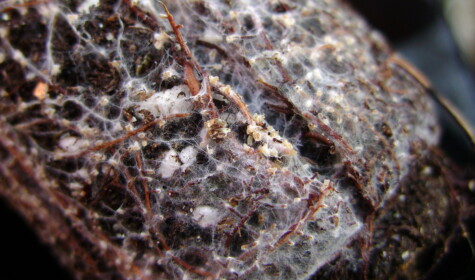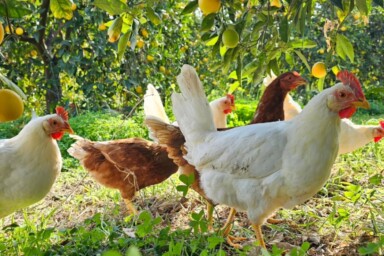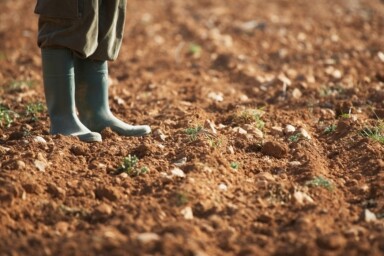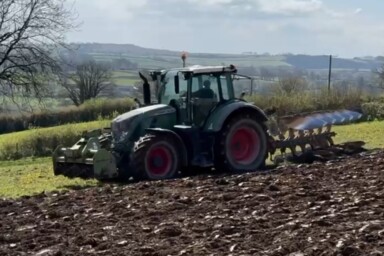Over recent years, no-till farming has been widely advocated as one of the ways to make farming more sustainable. It is also one of the paid options under Defra’s Sustainable Farming Incentive. But will the current trend away from ploughing towards direct drilling and the accompanying use of glyphosate bring the benefits advocates claim, or could this make matters even worse? Richard Young follows on from his article, Speed the plough or the direct drill and sprayer?, this time looking at mycorrhizal fungi and contrasting the impacts of ploughing, direct drilling and glyphosate on them.
With earthy humour in two well-known passages in Hamlet (4,iii,17-31 and 5,i,191-209), Shakespeare demonstrates an understanding of what early organic farming advocates termed ‘The Cycle of Life’ (seen in this very dated Soil Association film made more than seventy years ago). This refers to the natural processes by which all living things eventually die, decay and under normal circumstances return to the earth to be recycled. In Antony and Cleopatra, Shakespeare gives us one of the basics of sustainable farming, with the line, “Our dungy earth alike feeds beast as man,” (1,i,42-3).
What he could not have known is that the processes he describes, depend, amongst other things, on the action of mycorrhizal fungi. Early microscopes had recently been invented when he wrote these plays in the early 1600s, but they could only magnify up to 30 times normal size. To see mycorrhizal spores under a microscope, you need a magnification of at least 400 times.
Mycorrhizae work in harmony with plants, and both the plants and the fungi benefit from the relationship. The complex, sophisticated and fascinating world of mycorrhizal fungi was recently brought to public attention by biologist and tropical ecologist Merlin Sheldrake, in his widely acclaimed book Entangled Life. He took a broad look at mycorrhizae within the plant kingdom. I am only considering them in relation to agricultural crops.
An historical perspective
One of the first people to point out that healthy soil is alive, not only with invertebrates such as earthworms and soil spiders but also with literally thousands of different microorganisms, was Lady Eve Balfour in her book, The Living Soil. Amongst those are mycorrhizal fungi. She tells us (p.70) that, “Thread-like structures within root cells of certain vascular plants were first observed in 1829 and by 1847 had been identified as fungus mycelium.” Despite the absence of scientific consensus in 1943, when her book was published, she quickly recognised the major importance of soil microbial life, in particular mycorrhizal fungi, for plant and soil health.
A claim repeated in various ways, is that a teaspoonful of healthy soil contains more living organisms than there are people on the planet. The UK Centre for Ecology & Hydrology estimates that “One teaspoonful of topsoil contains around 1 billion microscopic cells and around 10,000 different species.” The global population has increased eight-fold since 1800, so while the original claim would have been true 223 years ago, it would be more accurate to say that there are now eight times more people on the planet than living organisms in a teaspoonful of healthy soil.
I am being pedantic, of course, but this has a relevance we should not overlook, in that population growth is one of the principal justifications used for further intensification of farming, albeit under the banner of ‘sustainable intensification’ which makes it sound harmless. While some farmers are undoubtedly making real efforts to farm in more sustainable ways, all the indications to date suggest that the bulk of the food we consume will continue to be produced in exploitative ways that are associated with a wide range of negative impacts and increased risks, including reductions in important soil microorganisms.
In 1951, pioneering organic farmer, Frank Newman Turner, took up the theme in his book, Fertility Farming, referring to mycorrhizal associations he writes (p.50), “It is this process which is vital to the health of the plant, for it is known that it takes place only in the presence of humus and that plants deprived of it, either by ‘short-circuit’ feeding or by lack of humus, succumb to pests and disease.” By ‘short-circuit’ feeding, he means the use of artificial fertilisers. By ‘lack of humus’ he is referring to the increasing trend, even then, to dispense with returning organic matter to the soil, for example, in the form of composted farmyard manure, that was made possible by the development of synthetic fertilisers. This reached its most extreme level in the 1970s, when tens of thousands of acres of straw were burned in the fields every summer in the UK, sometimes setting fire to hedgerows as well. The practice was finally banned in the UK in 1993 after years of campaigning by environmental organisations, such as Friends of the Earth, but has been permitted again by Defra on blocks of up to ten hectares (25 acres), as part of attempts to control the persistent weeds that plague many of the farms which have continuous arable crop rotations.
Newman Turner became a Council member of the Soil Association in 1952 and concern about the harm caused to mycorrhizal fungi by agrochemicals, especially the use of water-soluble phosphates, became part of organic farming philosophy and eventually influenced the Soil Association’s standards for organic food production when they were first published in detail in the 1980s. The consensus view today on this issue is that phosphate fertilisers do not kill off mycorrhizae, but they do reduce root colonisation by them.
Mycorrhizal fungi
Mycorrhizae form mutually symbiotic (mycorrhizal) relationships with about 80% of plants overall, but with 90% of agricultural crop plants. Oilseed rape and sugar beet, however, are among the small proportion of agricultural crops that do not form normal associations with mycorrhizae.
The extent to which plants and mycorrhizae work together is simply remarkable. Water, made more readily available to the plants by mycorrhizal fungi, is transported from the roots to the leaves by osmosis (as we generally learn at school), seemingly defying the laws of physics in the case of tall trees. But that is only half the story. At the same time, carbon dioxide taken from the atmosphere by the leaves and converted to carbohydrates by photosynthesis, is transported in the opposite direction to feed the mycorrhizal fungi, in the form of root secretions (exudates) containing sugars, amino acids, enzymes and more.
Merlin Sheldrake recently posted a video on Instagram showing this taking place in real time.
In return for the supply of nutrients from the plant, mycorrhizae invade its roots and effectively extend them through filaments (hyphae) which form networks (mycelia). This increases the plant’s ability to take up water and minerals, with mycorrhizae also playing a key role in breaking down organic matter in the soil to humus, from which plants in the natural world and on farms where synthetic fertilisers are not used, derive most of their own nutrition.
No-till farming and mycorrhizal fungi
Advocates of no-till farming make the claim that by not ploughing their soils they are automatically increasing soil biodiversity, including mycorrhizal fungi, and there are plenty of scientific studies to support this claim. But is it as simple as that, and are the increases very significant? Let’s get more basic information on the table first, then consider the question in detail.
Mycorrhizae weeds, plant diseases and pests
Scientists have shown that mycorrhizae can suppress weeds. In a study of six weed species amongst sunflowers, two weed species were reduced by mycorrhizae by between 59% and 66% while the remaining four declined by between 20% and 37%.
It has also been shown that mycorrhizae help to protect plants against root diseases, including ‘take-all’, a disease of cereals. The researchers say, “Our results show a clear systemic bio-protectional effect depending on the degree of root colonization by mycorrhizal fungi.” Some studies have also shown protective benefits in relation to foliar diseases, for example against powdery mildew in wheat. However, the overall situation with plant diseases above ground is still not clear, as this detailed review published in 2019 shows. Overall, mycorrhizae appear to make plants better able to fight off disease, but in some cases, they have been found to increase, rather than decrease, a plant’s susceptibility to viral infections. Whether or not that is related to the specific mycorrhizal species that predominate in continuous arable rotations, appears not to have been researched.
Viral diseases of cereal crops, such as cereal mosaic viruses, are a concern and can cause yield losses of up to 50%, but fungal diseases are as significant in both economic and food security terms. Inoculation with mycorrhizae has been used successfully in conjunction with other soil fungi, known as Trichoderma, to control stem rust diseases in wheat crops. Although currently rare in the UK, scientists have raised concerns about the potential for their re-emergence here.
It is known, however, that some major viral infections are spread by insects and at least one study, detailed in the review cited above, found that plants colonised by mycorrhizae were better able to survive attack by insects – in this case, aphids. It looks as if there is still a lot more to learn about plant diseases and mycorrhizal fungi. As the reviewers say, “Despite their economic importance, information on the effect of the AM [arbuscular mycorrhizae – the type of mycorrhizae which colonises crops] symbiosis on viral infection is limited and not conclusive.”
Mycorrhizae and soil structure
Mycorrhizae also benefit soil structure. It has only been widely known since 1996 that this is largely because they secrete glomalin, a glue-like substance, which helps to hold soil particles together and may also have other benefits, including helping to increase carbon and nitrogen storage in the soil. The elaborate networks of mycorrhizal mycelia clearly also help to improve soil structure and resistance to erosion. This appears to be the main aspect that ploughing can disrupt.
Reproduction
Mycorrhizae reproduce in three different ways, but spores (which can survive for five years), appear to be the main method by which arbuscular mycorrhizae colonise successive crops. Fragments of hyphae, the other main method, only remain viable for a few months. Research on four farms in Yorkshire found that mycorrhizae which colonise autumn-sown crops tended to die off over winter and that the crops were recolonised in the spring, presumably by spores. This suggests that providing there are adequate levels of spores in the soil, ploughing will make little difference to the level of colonisation.
Ploughing
There is, however, research evidence from conventional farms (where agrochemicals are used) from Canada and Mexico to show that mycorrhizae are found in larger numbers when land is direct drilled with no cultivations, compared with being ploughed. How significant those increases are compared with, for example, the higher levels of root colonisation on organic farms (see below), is not clear. What is abundantly clear is that mycorrhizae have declined under intensive arable systems. One study, by scientists from Sheffield, Leeds and York universities, which reviewed five separate studies on this aspect, concluded, “There is increasing evidence that high-input arable cultivation and cropping reduces the populations and activities of ‘ecosystem engineers’, organisms that maintain soil structure and function, including root symbiotic arbuscular mycorrhizal fungi.”
There are similar indications from a few other studies, though I have found fewer than I expected for such a significant issue. For instance, a study in Switzerland found evidence of lower numbers of mycorrhizal spores in ploughed soils, though it also found that the diversity of species was very similar in tilled and no-tilled situations.
Research shows that fields converted from grass to long term arable cropping experience major changes in the diversity of mycorrhizae. However, in contrast to all the evidence cited so far, at least one major review, in the journal New Phytologist, claims that the benefits associated with mycorrhizal fungi have been overstated and that at the present time there is little evidence to justify taking either diversity or abundance into account when managing crops.
It needs to be pointed out that most studies are not comparing the effects of ploughing and no-till in healthy soils, where naturally larger numbers of mycorrhizal spores would be expected. Instead, they are undertaken on land that has been degraded by decades of continuous arable production. The soils on such land have already experienced a significant decline in organic matter (approximately half of which is carbon). This plays a key role in maintaining mycorrhizal populations – organic matter levels have declined in European arable soils, 38% of which are degraded in England and Wales.
It seems reasonable to assume that deep ploughing will dilute the numbers of spores in the top of the soil profile, as well as break up fungal mycelia from the previous year’s crop. In a recent conversation with 92-year-old former Worcestershire farmer, Barrie Kent, who ploughed with horses as a young man, I was told that horse ploughing never went deeper than five inches, even on the best soils. Organic farmers are advised only to undertake shallow ploughing, not deeper than six inches. While there is a lack of research data on the impact of ploughing on levels of mycorrhizal spores, spores buried one year would still be viable when they came back to the surface the next time the field was ploughed. Avoiding deep ploughing would nevertheless appear to be sensible in relation to mycorrhizal fungi as well as seedling establishment and nutrition.
A new agricultural inputs market in the making
Some studies, though, are not focused on the impact on naturally occurring mycorrhizae at all, but on the benefits of using mycorrhizal spores as commercial inoculants for agricultural crops. The potential market is assumed to relate especially to those farmers who wish to reduce their dependence on expensive synthetic fertilisers. An international market for mycorrhizal spores has in fact been developing since at least 2008. However, a recent review of 25 commercial mycorrhizal inoculants concluded that only one of the inoculants resulted in higher yields. In addition, the study, referred to above, by scientists from Sheffield, Leeds and York universities, found no benefit from using commercially available mycorrhizal spores in a three-year trial in connection with ploughing and disc cultivations.
Fertilisers
Most studies that compare ploughing and no-till, do so in soils where both fertilisers and pesticides are being used; both groups of products can have negative impacts on mycorrhizae. Studies have found that where typical levels of phosphate and/or nitrogen fertilisers are applied to crops, the mycorrhizae decline, as the plants no longer rely on them to supply these essential elements from the soil. According to the analysis of a long-term study, which included regular applications of nitrogen fertiliser, “plants and soil microbes have a consistent response to long-term fertilization – both richness and diversity of plants and soil microbes are significantly decreased, as well as microbial functional genes involved in soil carbon (C), nitrogen (N) and phosphorus (P) cycling”. Another study in semi-arid grassland concluded, “AM [arbuscular mycorrhizae] fungal communities from N fertilized soils are less beneficial mutualists than those from unfertilized soils.”
Scientists tell us that in addition to soil disturbance, a wide range of pesticides can affect the diversity of mycorrhizal fungi. There has, however, been an inadequate level of research to establish trends in the diversity and population numbers of mycorrhizal fungi in agricultural soils more generally, in particular, to differentiate between the effects of ploughing, fertilisers, herbicides and fungicides.
Fungicides
Given that mycorrhizae are fungi, it might be expected that the very widespread use and number of fungicides used on intensive farms today would have a negative impact on them. Surprisingly, however, there is less research to be found on this than I expected. One recent study, however, found that the fungicide, mancozeb, reduced mycorrhizae, while a biological fungicide did not. Fungicides for cereal crops in the UK first became available about 55 years ago. The first products were just to control mildew. Since then, an arsenal of products has come onto the market which are widely used to prevent or reduce infection from an equally large number of diseases that have become a progressively greater threat to cereal production, as yields have been increased by plant breeding and higher use of inputs. Similar products are also used in other agricultural and horticultural crops. There appears to be a need for more research on the unintended impacts of these products, for example on mycorrhizae, both individually and when applied in combinations, as they sometimes are.
The impact of glyphosate on mycorrhizae
Unintended impacts of herbicides on mycorrhizae have been found. Research in Finland established that glyphosate reduces mycorrhizae. The researchers also discovered that while soil cultivation reduced the number of mycorrhizae, this was only significant in soils with a long history of continuous cultivation.
Contrary to the original manufacturer’s claims that glyphosate degrades a few weeks after it is applied, the scientists found residues in plants in the following growing season, as well as reduced levels of beneficial mycorrhizae. The emerging consensus on this aspect appears to be that glyphosate will often degrade relatively quickly, but that various factors, including low temperatures, can slow this significantly. In Argentina, a country where glyphosate is used on GM crops, it has been suggested that it should be considered as a “pseudo-persistent” pollutant because, “application rates are higher than dissipation rates”. Speculating, this should, perhaps, be investigated in the UK in situations where glyphosate is used several times a year, such as post-harvest, pre-sowing and as a desiccant pre-harvest, especially in parts of the country where temperatures over winter are cold enough to slow its breakdown significantly.
Another study in Argentina found that when applied to the soil, glyphosate affected the viability of spores even at a very low rate of 0.8 litres per hectare. Total root colonisation with mycorrhizae was also reduced when glyphosate was applied to the soil or to foliage, with no difference between high and low application rates. While some studies have found positive, negative and neutral impacts depending on a range of factors, a 2014 study by German and Austrian scientists “found that herbicides [glyphosate in this study] significantly decreased root mycorrhization, soil AMF spore biomass, vesicles and propagules”. A 2013 study in Argentina found similar results and was able to quantify the impact. The viability of mycorrhizal spores in soils not treated with glyphosate was between 5.8 and 7.7 times greater than in soils that were treated with it.
Organic farming and mycorrhizae
Advocates have claimed for many decades that organic farming creates the best conditions for mycorrhizae and that this, in turn, is a key reason for its technical success given the non-use of synthetic inputs and relatively high productivity. While there is no direct evidence of the impact which mycorrhizae have on the yields of organic crops, there is good evidence to show that organic farming leads to healthier mycorrhizal communities. For instance, a Dutch study found that arable fields under organic management had more arbuscular mycorrhizal fungi species than conventionally managed ones, with the difference becoming increasingly significant as time passed, following conversion to organic methods. The same study also showed that organic soils had mycorrhizal communities which were more diverse, and more similar to those found under natural grasslands – a finding that was replicated in this Swiss study. Why this is the case is not known for certain, but it is assumed to be due to the avoidance of synthetic fertilisers and biocide use in organic farming.
An interesting observation to take from these findings is that tillage – a key feature of organic arable production, and therefore a practice whose impacts were captured in the studies mentioned above – can clearly be compatible with healthy mycorrhizal communities. Still, there is evidence from one study finding that a reduction in tillage intensity in organic production does lead to even higher mycorrhizal spore densities and species richness. With some organic farmers already experimenting with ways of reducing their reliance on ploughing (without, of course, using glyphosate or other herbicides), this is something which may spur further interest in this area.
Several other studies have also found higher populations of mycorrhizae on organic farms. A 2010 study found the highest levels of mycorrhizae in grasslands, somewhat lower levels in organically managed crop fields and significantly lower levels on conventionally managed fields. Another Swiss study found that a much greater proportion of plant roots were colonised by mycorrhizal fungi in organic arable systems compared with conventional ones.
The importance of grass
A key component of mixed organic farms, and by extension many regenerative farms, is that they include short-term grass and clover leys in their arable cropping rotations. This may be one of the main reasons that mycorrhizae are more plentiful in organically managed soils.
A recent study involving scientists from several UK universities found that introducing a grass/clover ley on land that had been in intensive arable production for more than 10 years resulted in a rapid recovery in earthworm populations with numbers four times higher than in an adjacent arable field after just two years. In the study by scientists from three UK universities (already cited twice, above) wheat achieved yields of 92–106% of national average yields following a three-year grass/clover ley, but with just 25% of the normal nitrogen fertiliser application rate and no use of fungicides. This study used herbicides on the growing crops and glyphosate with direct drilling to kill the grass ley. It would have been particularly interesting to the organic sector to have seen a comparison where the ley had been ploughed instead of treated with glyphosate.
Conclusion: How significant is the damage to mycorrhizae caused by ploughing?
Given the importance of mycorrhizae for the health, resilience (in the face of droughts and heavy rain) and (with the possible exception of inoculated crops), the productivity of croplands where low or no inputs are used, it is surprising that so little research has specifically addressed this question. Several teams of scientists suggest that more research is needed on a number of issues relating to mycorrhizae. There is sufficient evidence to say that soil that has been producing crops continuously for many years will have lower than ideal levels of mycorrhizae and an altered range of mycorrhizal species. Some reports suggest these can be very low, but levels appear to vary, and it is not obvious what the range is, or precisely which factors make the most difference.
It is, however, clear that in addition to ploughing and other cultivations which physically damage the mycelia, the use of synthetic fertilisers, glyphosate and at least some other pesticides have significant negative impacts on mycorrhizae. How might we explain the good yields of wheat in the study by Sheffield, Leeds and York universities despite the use of glyphosate and low use of nitrogen fertiliser? Two things seem worth pointing out. First, I have occasionally produced organic wheat yields in good years on my best land straight after grass, approaching 7 tonnes per hectare from milling wheat varieties (which are lower yielding than feed wheat varieties). In such situations nitrogen is not a limiting factor and I doubt if it would have made much difference if they had used no nitrogen fertiliser at all. Second, and here I can only speculate, it seems possible that over time repeated glyphosate applications would reduce yields in a low or no input situation, if, as several studies suggest, this is steadily degrading the mycorrhizae.
It seems possible, and if so ironic, that the negative impacts on mycorrhizae from fertilisers, herbicides, including glyphosate and fungicides, may be masked to some extent at present by increased use of the same fertilisers and pesticides that are reducing the mycorrhizae. When it comes to protection against disease, the picture is even less clear. There is increasing evidence of the role mycorrhizae play in providing partial immunity to disease, but insufficient evidence to say exactly which diseases can be repelled and which not.
From the perspective of organic and other mixed farms, where crops are grown in rotation with grass/clover leys, there is good evidence that this increases or maintains high levels of mycorrhizae, as the comparative organic and conventional studies cited above demonstrate. Ploughing, inevitably, does some damage, but with mycorrhizal spores able to colonise plant roots and start bringing benefits in just a month or so, and strong evidence that mixed organic farms are better for mycorrhizae than conventional ones, the careful use of ploughing is compatible with healthy mycorrhizal communities on organic farms.
However, given that organic farmland still only accounts for a relatively small proportion of total farmland, it is necessary to consider ploughing versus glyphosate in standard intensive systems. It may be that in such situations, no-till does bring advantages over ploughing. It should be noted, however, that since a range of herbicides (including glyphosate) is used on most conventional farms, a completely balanced, comparative assessment of ploughing versus no-till may not yet ever have been undertaken. Finally, the research I have read for this article is sufficient for me to suggest that regenerative farmers who want to make their farms as sustainable as possible, should not be frightened about giving up glyphosate and re-embracing the use of shallow ploughing
We would like to thank Professor Jonathan Leake (who read an early draft of this article and provided advice and information) and Philip Conford who kindly searched in vain for information on when the damage to mycorrhizae caused by water-soluble phosphate fertilisers was first raised in a Soil Association publication. Robert Barbour reviewed the organic studies and provided helpful comments.
Featured image licensed under the Creative Commons. Click here to view original.







